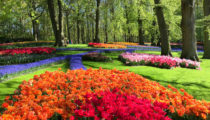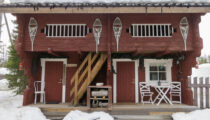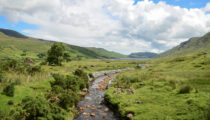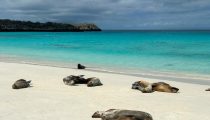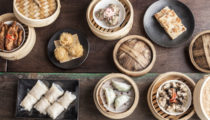May 18, 2009
A Conversation with Renowned Art Curator David Elliott
We recently caught up with David Elliott, the British-born, globetrotting curator. A major tastemaker in the contemporary art world, Elliott has been the director at the Mori Art Museum in Tokyo, Japan and at the Istanbul Modern in Turkey, helping introduce a fresh approach to contemporary art in both cities. Elliott’s current post is artistic director for the 17th Biennale of Sydney, an important contemporary art exhibition opening in 2010 in Australia.
Q: You were the director of the Mori Art Museum in Tokyo and the Istanbul Modern in the early years of both museums. How did these museums change the art scenes in their respective cities?
A: I spent five years in Tokyo setting up and programming the Mori Art Museum. It provided a new and popular perspective on modern and contemporary art that was of a high quality and accessible to the general public. It bridged the gap between the Japanese and international audience while devising its programs from a uniquely Japanese perspective. I stayed at the Istanbul Modern as Director for nine months and while I believe it has great potential to fulfill a similar task from a Turkish perspective, under the conditions that prevailed at that time it was not possible for me to achieve this potential.
Q: You are currently the artistic director for the 17th Biennale of Sydney, which opens in May 2010. What’s your vision for the exhibition, which is entitled “The Beauty of Distance: Songs of Survival in a Precarious Age”?
A: The 17th Biennale of Sydney will take place in venues and sites around the world famous Harbour, which is also the site of the first encounters the European explorers had with the people who lived there. Situated in the heart of the city, in a land that has traditionally regarded distance as a disadvantage, it will include art from around the world and examine the significance of distance in a number of different ways.
Firstly, distance allows us to be ourselves despite the many capacities we share. We are all the same, yet different and it is our differences that make us—according to the circumstances—beautiful, terrifying, attractive, boring, sexy, unsettling, fascinating, challenging, funny, stimulating, horrific, or even many of these at once. I would like to celebrate this. More importantly, the idea of distance expresses the condition of art itself. Art is of life, runs parallel to life and is sometimes about life. But, for art to be art (a medium of numinous, sometimes symbolic power), it must maintain a distance from life. Without distance, art has no authority and is no longer special. As art depends on the beauty of distance, beauty in art—a resolution of energy, thought and feeling in aesthetic form—depends on distance as well. Beauty itself can, at times, be terrible as well as alluring. Art can reflect the strongest of emotions, the most upsetting of events and nobody gets hurt.
The subtitle of the Biennale—”Songs of Survival in a Precarious Age”—explores the affirmative power of art in the face of unprecedented threats: conflict, famine, inequity, environmental despoliation and global warming. This title is inspired by experimental film maker, anthropologist and musicologist Harry Everett Smith (1923-91) whose boxed set of historic recordings American Folk Music appeared in 1952 at the height of the Korean war and of Senator McCarthy’s political witch hunts in the USA. Drawing on blues, jazz, gospel and different forms of folk music from people of many origins living across the USA, Smith traced a modern world with very different values from those he saw around him. In doing this, he provided guidance and inspiration for generations of future artists, musicians and listeners.
Q: For travelers who may not be familiar with biennales and the Biennale of Sydney, why should they consider visiting Australia during the exhibition and what can they look forward to?
A: Visitors will experience a major exhibition of contemporary art from an Asian/Pacific perspective that reflects the actual state of contemporary art and the worlds around it. The Biennale is embedded in the fabric of the city, including Cockatoo Island, a heritage site which used to be both a prison and a ship yard, and is in a conversation with the history of the city and its future creative potential. A program of related concerts, performances, films and events will coincide with the Biennale.
Q: What do you think makes Sydney a great city?
A: The combination of primordial nature in the Royal Botanic Gardens, where cockatoos, possums and flying foxes as well as the sub-tropical flora of the region have their habitat, with the Harbour, its bridge, the Sydney Opera House, and high-rise buildings by such renowned architects as Norman Foster, Renzo Piano and Harry Seidler, is breathtaking.
Q: What’s your favorite museum in Sydney?
A: This has to be a draw between the Art Gallery of New South Wales and the Museum of Contemporary Art. Both will host parts of the Biennale.
Q: What would be a perfect day in Sydney?
A: A perfect day would be to go out on a boat to the headlands at the mouth of the Harbour, swim a little in one of the many coves and to round it off with a meal of local oysters and Australian Sauvignon Blanc in one of the small restaurants around the harbour. Alternatively, a pub crawl around the Rocks ending up at the Lord Nelson, which has a great restaurant and brews its own beer, would not be bad.
Q: …in Istanbul?
A: In Istanbul, I would go first to look at the Byzantine architecture, frescos, and mosaics at the Chora Church and also walk along the old city walls nearby, I would then visit the Hagia Sophia [Aya Sofya], originally a Basilica built by the Emperor Constantine, then a mosque, now a museum, and walk round some of the small mosques designed in the mid-16th century by Mimar Sinan in the same area. The best of these have beautiful painted tiles, such as the one tucked away in the corner of the small square opposite the Spice Market. I would then either take a boat up the Bosphorus to the mouth of the Black Sea or go to some of the small restaurants and bars around Taksim Square.
Q: …in Tokyo?
A: In Tokyo, my perfect day would be to visit the Taniguchi Pavilion [Gallery of Horyuji Treasures] in the Tokyo National Museum in Ueno Park, walk up the hill to the old cemetery of Yanaka, visit the old temples round it and some of the contemporary art galleries while stopping off at a small udon restaurant which is over one hundred years old. I would start my evening in Roppongi’s SuperDeluxe bar and performance space (also featuring in the Biennale), followed by some small bars in Shibuya and then probably on to Golden Gai in Shinjuku for a final nightcap.
Q: How did you get involved in art? What drew you to a career as a curator and museum director?
A: When I was a kid, I wanted to be a theater director but when I left school, I worked in a theater for a while and realized that it was not my future. Then, while I was an undergraduate at Durham University, I started making art exhibitions as a way of understanding why the world is as it is and how different kinds of power affect people in different ways. The first series of exhibitions I made when I was twenty years old, which also included programs of film, music and theater, was called “Germany in Ferment. Art and Society 1900-1933.” I wanted to find out why bad dictators were afraid of good art and what power art had in the face of tyranny. I’m still finding out.
Q: How does your experience of living and working in different parts of the world play into your curatorial choices?
A: Working and living in different cultures helps you to understand that there are always many different and equally valid perspectives on any issue—something I was beginning to understand even before I left the UK.
Q: Why is contemporary art important?
A: Contemporary art touches on all aspects of life—dreams, thoughts, emotions and reality—and attempts to bring them together in aesthetic form. The distillation or resolution of these elements in art of high quality provides a unique experience, rivalled for me only by a contemplation of the beauty and power of nature. Art, if it is any good, also enshrines values of freedom which are always being threatened. The freedom of art to be itself is a metaphor for broader political and social freedoms. History has shown us that they are connected.
Q: What are some of your favorite places in the world?
A: India and Nepal, Japan, Hong Kong, the Yorkshire Pennines.
Q: If you had to choose a favorite hotel anywhere in the world, which would it be?
A: The Mao Suite in the Red Capital Hotel in Beijing. This was Mao’s secret hutong hideaway, virtually unchanged with even the same furniture and bed. The “cocktail bar” is down steep narrow steps in the nuclear bunker under the courtyard.
Q: What do you like to do when you travel for leisure?
A: Walk, read, look at art, architecture, rocks and water.
Q: Do you collect anything?
A: As I work in the public sphere, it would be a conflict of interest for me to collect contemporary art. On the rare occasions I have spare cash I spend it on Japanese prints, small Asian bronzes, traditional Tibetan or Mongolian paintings, and books.
Q: What’s your most prized possession?
A: An 18th-century Mongolian tanka of Yama, the terrifying lord of destruction and creation, and a small 11th-century Cham bronze of the Hindu God, Ganesha.
Q: What are you reading right now?
A: Thomas Pynchon’s “Gravity’s Rainbow.”
All Artisans of Leisure tours can be customized to include the most interesting museums, galleries, and art sites, as well as modern and contemporary architecture, in each destination. Tours can also be designed to cooncide with art fairs, biennials and other art exhibitions.
Destinations: Asia, Europe, South Pacific, UK
Tags: architects, art, art experts, art tours, Artisans of Leisure, Asian, beauty, Biennale of Sydney, Biennale tours, Britain, British, cities, city, contemporary art, culture, curated, curator, David Elliott, European, exhibitions, globetrotting, hotels, international, luxury, luxury resorts, luxury tours, luxury travel, modern, modern art, museum tours, museums, paintings, private, tastemaker, tours, travel, travel blog, travel experts, trips

 MENU
MENU